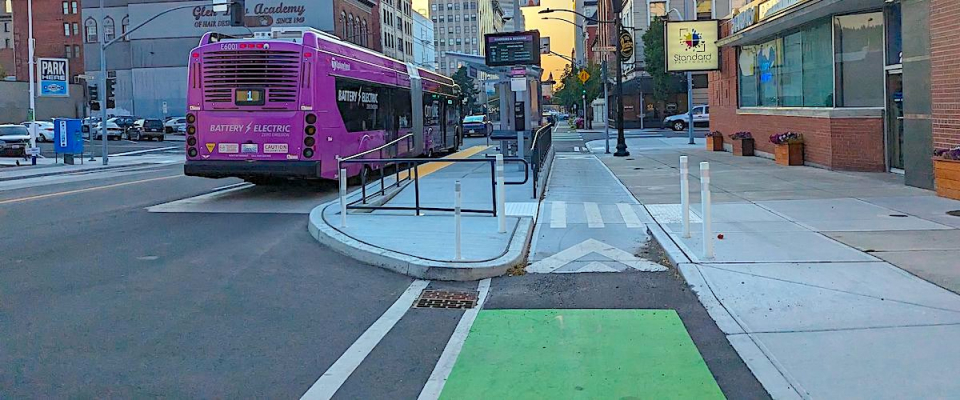PSU Researchers Will Develop Safe System Tools for Washington Department of Transportation

In a new project that's just getting underway, Portland State University researchers will work with researchers at the University of North Carolina (UNC) at Chapel Hill to develop tools and a decision-making process to proactively design and retrofit roadways to make them safer.
Led by Sirisha Kothuri of the Maseeh College of Engineering & Computer Science and supported by the Washington Department of Transportation (WSDOT), the effort aims to help WSDOT implement a Safe System Approach to prevent dangerous crashes. They intend to implement safe systems in conjunction with another principle embraced by WSDOT and many other transportation agencies, the Complete Streets concept. Complete Streets is a planning and design method that prioritizes safe access for all road users.
"PSU along with UNC is excited to help WSDOT implement the Safe System Approach to road safety within the Complete Streets context. This work aims to reduce crashes for all road users generally, and in particular to eliminate fatal and serious injury crashes," Kothuri said.
WHY THE SAFE SYSTEM APPROACH?
As described by the United States Department of Transportation (U.S. DOT), the Safe System Approach has been embraced by the transportation community as an effective way to address and mitigate the risks inherent in our transportation system. It works by building and reinforcing multiple layers of protection to both prevent crashes from happening in the first place and minimize the harm caused to those involved when crashes do occur. It is a holistic and comprehensive approach to making places safer for people.
In the 2022 Legislative session, with WSDOT input, Washington's state transportation budget included requirements to develop Complete Streets projects using safe system principles. The U.S. DOT, too, has formally adopted the approach as part of its National Roadway Safety Strategy. The Safe System Approach calls for strengthening every part of the transportation system with safer roads, safer vehicles, safer speeds, safer road users, and post-crash care to create an overlap of countermeasures that prevent death and serious injury.
PROJECT GOALS AND OBJECTIVES
Current fatality and serious injury trends continue to rise steeply for all road users, particularly vulnerable users, in both Washington State specifically and across the United States more broadly. With the $199,750 in funding from WSDOT, the PSU research team will spend the next two years developing a knowledge base to enable planners and engineers to influence planning, programming, design, and operational decisions in order to reduce fatal and serious injury crashes.
Included in this knowledge base will be specific, illustrated approaches for evaluating route directness (RDI) and level of traffic stress (LTS) on both the corridor level and project level. The team will identify potential approaches to navigating the problem of traffic stress: Either by directly lowering the LTS of a roadway through strategies like lowering speeds, reducing lane number, or reducing annual average daily traffic so that less costly multimodal facilities will be needed; or else by mitigating LTS with robust multimodal treatments.
The researchers will create tools in the form of matrixes, tables, worksheets and other systems that will enable the people involved in planning, scoping, and designing Complete Streets to identify specific solutions (treatments, or suites of treatments) that act as mitigations to lower LTS to the Complete Streets goal.
NEXT STEPS
To begin this work, the research team will first consult with WSDOT to select a variety of sites for case studies. The selected sites will contain intersections and roadway segments with different characteristics in terms of roadway geometry (intersection or segment configuration), traffic volumes (vehicle and non-motorized), transit service and availability, and roadway context (land use typologies, equity metrics, and other built-environment or sociodemographic characteristics).
The case study analysis will focus on how geometric, operational, and contextual features contribute to crashes. Results of the evaluations will be compared to determine the effects on safety of different site-specific characteristics.
THE PROJECT TEAM
Applying the Safe System Approach in Decision-Making
The team, consisting of researchers from Portland State University and the University of North Carolina at Chapel Hill, bring a wealth of experience in the Safe System Approach. Sirisha Kothuri of PSU and Wesley Kumfer of UNC will be the Co-Principal Investigators on this study. They will be assisted by PSU's Jason Anderson and UNC's Stephen Heiny and Alessandro Figueroa.
Photo by Dongo Chang, WSDOT State Traffic Engineer and Director of Transportation Operations
Portland State University's Transportation Research and Education Center (TREC) is home to the U.S. DOT funded National Institute for Transportation and Communities (NITC), the Initiative for Bicycle and Pedestrian Innovation (IBPI), PORTAL, BikePed Portal and other transportation grants and programs. We produce impactful research and tools for transportation decision makers, expand the diversity and capacity of the workforce, and engage students and professionals through education and participation in research. To get updates about what's going on at TREC, sign up for our monthly newsletter or follow us at the links below.
Facebook | Instagram | LinkedIn | TikTok | Threads | X | YouTube
Share this:
- ‹ Older
- Newer ›
